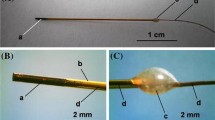Abstract
The at-line coupling of capillary electrophoresis (CE) and surface-enhanced resonance Raman spectroscopy (SERRS) was optimized for the separation and subsequent spectroscopic identification of charged analytes (dye compounds). Raman spectra were recorded following deposition of the electropherogram onto a moving substrate. To this end a new interface was developed using a stainless steel needle as a (grounded) cathode. The outlet end of the CE capillary was inserted into this metal needle; CE buffer touching the needle tip served as the electrical connection for the CE separation. A translation table was used to move the TLC plate at a constant speed during the deposition. The distance between the tip of the fused silica column and the TLC plate was kept as small as possible in order to establish a constant bridge-flow, while avoiding direct contact. The dyes Basic Red 9 (BR9), Acid Orange 7 (AO7) and Food Yellow 3 (FY3) were used as test compounds. After CE separation in a 20 mM borate buffer at pH 10, after deposition, concentrated silver colloid was added to each analyte spot, followed by irradiation with 514.5 nm light from an argon ion laser to record the SERRS signal using a Raman microscope. Different types of silver colloids were tested: Lee–Meisel type (citrate), borate, and gold-coated silver. BR9 (positively charged) gave much more intense SERRS spectra than the two negatively charged dyes. For BR9 and AO7 the citrate-coated Lee–Meisel colloid yielded the most intense SERRS spectra. The CE–SERRS system was used to separate and detect the negatively charged dyes. Silver colloid and nitric acid (to improve adsorption) were added post-deposition. Even though their chemical structures are very similar, AO7 and FY3 could be readily distinguished based on their SERRS spectra. The limits of detection (S/N=3) of the CE–SERRS system ranged from 6.7×10−5 M (2.6×10−12 mol injected) for FY3 down to 1.8×10−6 M (7.0×10−14 mol injected) for BR9.





Similar content being viewed by others
References
Wilson ID, Brinkman UATh (2003) J Chromatogr A 1000:325–356
Schmitt-Kopplin P, Frommberger M (2003) Electrophoresis 24:3837–3867
Asher SA, Munro CH, Chi Z (1997) Laser Focus World 33(7):99–109
Gooijer C, Mank AJG (1999) Anal Chim Acta 400:281–295
Laserna JJ (1996) Modern techniques in Raman spectroscopy. Wiley, New York, ISBN 0-471-95774-7
Kowalchyk WK, Walker PA, Morris MD (1995) Appl Spectrosc 49:1183–1188
Nirode WF, Devault GL, Sepaniak MJ (2000) Anal Chem 72:1866–1871
DeVault GL, Sepaniak MJ (2001) Electrophoresis 22:2303–2311
Kneipp K, Wang Y, Kneipp H, Perelman LT, Itzkan I, Dasari R, Feld MS (1997) Phys Rev Lett 78:1667–1670
Seifar RM, Dijkstra RJ, Gerssen A, Ariese F, Brinkman UATh, Gooijer C (2002) J Sep Sci 25:1–6
Carron K, Milofsky R, Kennedy B, Jiang J, Deschaine T, Dickey M, Lewis M (1996) P Soc Photo-Opt Inst 2835:54
Dijkstra RJ, Gerssen A, Efremov E, Ariese F, Brinkman UATh, Gooijer C (2004) Anal Chim Acta 508:127–134
Nirode WF, Devault GL, Sepaniak MJ (2000) Anal Chem 72:1866–1871
He L, Natan MJ, Keating CD (2000) Anal Chem 72:5348–5355
Sweedler JV (1994) Anal Chem 66:2382–2389
Tracht SE, Cruz LA, Stobba-Wiley CM, Sweedler JV (1996) Anal Chem 68:3922–3927
McLeod GS, Axelsson J, Self1 R, Derrick PJ (1997) Rapid Commun Mass Sp 11:214–218
Lee PC, Meisel DJ (1982) Phys Chem 86:3391–3395
Creighton JA, Blatchford CG, Albrecht MG (1979) J Chem Soc Farad T 75(2):790–798
Rivas L, Sanchez-Cortes S, Garcia-Ramos JV, Morcillo G (2000) Langmuir 16:9722–9728
Munro CH, Smith WE, White PC (1993) Analyst 118:731–733
Dou X, Jung YM, Cao Z-Q, Ozaki Y (1999) Appl Spectrosc 53:1440–1447
Seifar RM, Verheul JM, Ariese F, Brinkman UATh, Gooijer C (2001) Analyst 126:1418–1422
Acknowledgements
The dyes were kindly donated by J.W. Wegener (Institute of Environmental Studies, Vrije Universiteit Amsterdam). This work was carried out during a temporary research visit of D.A.R. to the Laser Centre Vrije Universteit Amsterdam, made possible by the EU Access to Large Scale Research Infrastructures programme, contract# HPRI-CT-1999-00064.
Author information
Authors and Affiliations
Corresponding author
Additional information
D. Arráez Román and E. Efremov contributed equally to this work.
Rights and permissions
About this article
Cite this article
Arráez Román, D., Efremov, E., Ariese, F. et al. Interfacing capillary electrophoresis and surface-enhanced resonance Raman spectroscopy for the determination of dye compounds. Anal Bioanal Chem 382, 180–185 (2005). https://doi.org/10.1007/s00216-005-3164-x
Received:
Revised:
Accepted:
Published:
Issue Date:
DOI: https://doi.org/10.1007/s00216-005-3164-x




